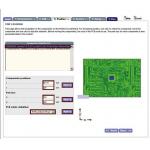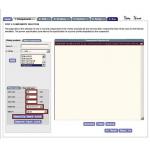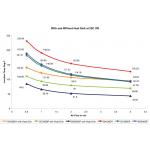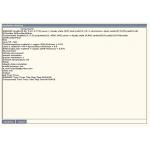February 1, 2007
By Tom Kevan
Vishay Siliconix of Malvern, PA, a manufacturer of discrete semiconductors and passive electronic components, is breaking new ground by offering designers of data acquisition boards and silicon-based sensors a MOSFET (metal-oxide semiconductor field-effect transistor) thermal simulation tool online. The web-based software, ThermaSim, simulates the thermal performance of Vishay MOSFETs by showing how adjacent components affect them. By including these components in the analysis, the software ensures optimal device selection and eliminates fallouts during thermal performance testing, ensuring the MOSFET is functioning within its limits. With this capability, design engineers can map the thermal characteristics of the components on the PCB and optimize their design before prototyping, speeding time to market. And the price is right — it’s free.
A Marriage of SoftwareThermaSim is powered by Epsilon Ingenierie’s Rebecca-3D software, a stand-alone electro-thermal design and simulation package that lets you define material properties and build material databases; it offers equivalent-material properties tools. Rebecca-3D uses the boundary element method to solve conduction equations, including equations for nonlinear material. And the software’s powerful algorithms significantly reduce the computation time required for mesh generation.
Figure 1: In the third step of defining the characteristics of elements of the simulation, you set the size of the printed circuit board (PCB), specify the positions of components on the board, and define the pad size and solder.
Using finite element analysis (FEA), Rebecca-3D takes the physical structure of the MOSFET and its parts and breaks them into smaller and smaller components. It then applies the thermal conditions to the smaller segment of the component and calculates the temperature effect on that particular mesh. The thermal effect of one mesh on the next is calculated, and so on, requiring a huge amount of computation. It is repeated until it reaches a steady state and a stable number of results.
“The mesh is a smaller segment of the entire component,” says Kandarp Pandya, senior staff application engineer for Vishay Siliconix. “It is like dividing a cube into a number of smaller cubes. This process creates a mesh. The mesh is the collection of the cubes. You apply the profile condition, dividing it by the number of meshes, calculating the cumulative thermal effect on the mesh. You are also calculating the interaction among them, where the stable number is applied to the next mesh.”
Figure 2: In another step of the simulation setup, you define the heat sink’s size, material, and attachment material.
For its part, ThermaSim provides a web interface that lets you define the simulation parameters and requirements and converts the data to a format that Rebecca-3D can interpret. ThermaSim also provides a library of structurally detailed 3D models of Vishay’s power MOSFETs that are created using FEA techniques to increase the simulation’s accuracy. The models define the physical and material properties of each element of the MOSFET.
Although there are several other software packages that Vishay could have chosen to perform the thermal simulations, Rebecca-3D seems the best suited because it performs only thermal analysis, is not encumbered by functionality not required by the application, and is easy to use. Other applications are much more comprehensive in their scope, covering more than thermal analysis, and require more expertise and experience. They also come with a higher price tag. In short, they add a level of complexity not justified if you’re interested in only performing thermal analysis.
For example, “ANSYS is a full-blown finite element analysis package,” says Pandya. “It’s a CAD platform. You start with all the dimensions of the physical structure of the component and attribute different properties to it ]the component]. In the case of ANSYS, you can not only attribute thermal properties but also the electrical, mechanical, or any other physical properties and do the analysis — stress, magnetic, or whatever. And this is where things become complex. This is overkill. It starts to become complicated when you have the built-in capability to do so many things.”
Other software applications superbly perform thermal analysis, but these packages are specialized and perform on a limited scale, focusing only on the PCB or the housing, making their capabilities too limited to handle the total thermal picture of the MOSFET.
When power dissipation occurs in a MOSFET, heat in the component should not rise beyond an established threshold. Out-of-limit thermal levels can reduce the reliability of the MOSFET and the PCB, or worse, destroy both elements. To establish thermal levels, analysis and simulation focuses on three properties: material density, thermal conductivity, and specific heat.
Figure 3: ThermaSim makes it possible to compare the thermal performance of different MOSFET designs, under different conditions. The graph tracks multiple simulations.
ThermaSim is rich in features, and the setup is easy and comprehensive. As a first-time user, your first step is to register online. After that, the program walks you through a step-by-step process in which you select the appropriate MOSFET thermal model from the library and define the characteristics of individual components. In this phase, you define the PCB’s size, layers, material, and copper spreading; set pad size and solder quality (see Figure 1, above); define the heat sink size, material, and attachment methodology (see Figure 2, above); and select the power-dissipation profile, system temperature, air flow, and assembly orientation with respect to gravity to correctly account for the effect of convection.
Figure 4: ThermaSim’s simulation results include thermal images and temperature readings of the components evaluated. These are part of the package emailed to you upon completion of the simulation.
In the third phase, you configure the simulation. Here you choose between steady-state or transient runs, specify the accuracy level, and indicate whether or not you want to save your configurations in a database. At this point, you can provide the e-mail address for the person to whom the results should be sent.
ThermaSim also e-mails simulation results directly to you. Thermal images are provided and an MPEG video clip of the thermal image with transient simulation is also available. You can download simulation results into Microsoft Excel, and can merge multiple results with varying product, package, or other input data into Excel to compare and examine trends (see Figure 3, above). You can also opt to save simulations for modification later on.
Everything ConsideredVishay’s ThermaSim has both pros and cons, but in the end, it gets high marks, with limited use. Its online availability takes accessibility to a new level, and it’s good to see vendors offering these services, using this medium. ThermaSim’s strong point is its simulation software, Rebecca-3D, which is well-focused on the thermal simulation of MOSFETs. It has enough functionality to adequately cover the big picture, but it isn’t weighed down with a lot of unnecessary bells and whistles. Last but not least, the price is right. It’s hard to quibble with free.
The only real drawback that I see is that it has limited applicability: It only works with one company’s products.
Tom Kevan is a New Hampshire-based freelance writer specializing in technology. Send your comments about this article through e-mail by clicking here. Please reference “Mapping heat Online” in your message.
A MOSFET is basically a power switch. On a data acquisition (DA) board it can serve two functions: it regulates the board’s power supply and connects or disconnects I/O points.
The DA board relies on a power supply to make the circuit run. When supplying electrical power to an electronic circuit, you need to have a regulated power supply to ensure the power has a level of stability and you can predict how the signal is going to vary. Power MOSFETs play a key role in delivering a regulated power supply.
MOSFETs can also play a role at the I/O level, where the physical data collection occurs. At these points, there may be individual channels or multiplexing. All the channels or multiplexing can be configured using a MOSFET to connect or disconnect them.—T.K.
Info
ThermaSim
Vishay Intertechnology, Inc.
Malvern, PA
Subscribe to our FREE magazine, FREE email newsletters or both!
About the Author
DE’s editors contribute news and new product announcements to Digital Engineering.
Press releases may be sent to them via [email protected].






